AMD’s Ryzen 7 2700 CPU: The Ultimate Multi-Core Value?
Pros
Cons
Rating
Introduction
 In this review, we’ll be taking a close look at the Ryzen 7 2700, in part because its predecessor, the Ryzen 7 1700, proved itself to be a wolf in sheep’s clothing and a true favorite of overclockers. Will the 2700 offer the same punch-per-dollar? We’re about to find out!
In this review, we’ll be taking a close look at the Ryzen 7 2700, in part because its predecessor, the Ryzen 7 1700, proved itself to be a wolf in sheep’s clothing and a true favorite of overclockers. Will the 2700 offer the same punch-per-dollar? We’re about to find out!
And by the way, there were a couple of other elements of Ryzen performance that we didn’t get to explore in depth in our first review that we thought might hold interest to our readers, namely four-stick RAM compatibility and AMD’s StoreMI drive acceleration solution. We’ll be touching on both of those this time around.
Special thanks to AMD for providing TBG with a sample of the Ryzen 7 2700 processor and the MSI Gaming M7 AC motherboard featured in this review.
Test Setup
Here’s a list of the components we used, along with a photo showing the system sans video card to give you a good look at the motherboard:
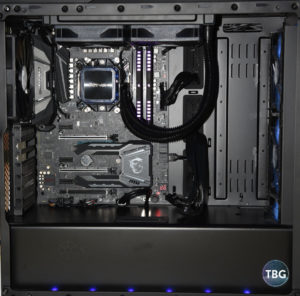
- CPU: AMD Ryzen 7 2700
- Motherboard: MSI Gaming M7 AC
- Video Card: EVGA GeForce GTX 1080 8GB FE
- RAM: Corsair 2x8GB Vengeance RGB DDR4-3000
- SSD: Samsung 960 Evo 500GB
- CPU Cooler: Reeven Naia 240
- Power Supply: SilverStone Strider 850W Platinum
- Case: SilverStone Primera PM01-RGB
- OS: Windows 10 Home with 2018 Spring Update applied
All of the following CPUs/motherboards will make an appearance in this article:
- AMD Ryzen 7 1700 3.2GHz octo-core (released at $329 in March 2017) running on Gigabyte AB350-Gaming 3
- AMD Ryzen 5 2600X 3.6GHz hexa-core (released at $229 in April 2018) running on Asus Crosshair VII Hero (Wi-Fi)
- AMD Ryzen 7 2700X 3.7GHz octo-core (released at $329 in April 2018) running on MSI X470 Gaming M7 AC
- Intel Core i7-7700K 4.2GHz quad-core (released at $350 in January 2017) running on Gigabyte Z270X-UD3
- Intel Core i7-6900K 3.2GHz octo-core (released at $1,100 in June 2016) running on Asus X99 Pro/USB 3.1
For our testing, we’re using two CPU benchmark tests (CPU-z and Cinebench), one game benchmark test (3DMark Time Spy), and three real-world games: Rise of the Tomb Raider, DOOM, and Rocket League. All game benchmarks were run at a 2560×1440 resolution, which is becoming the new norm for high-performance gaming, and is not a serious challenge for the Nvidia GeForce GTX 1080 video card we used, meaning the pressure was on the CPU subsystem. You might see CPU game benchmarks run at 1920×1080 or lower resolutions (like the absurd 800×600), but we feel it’s a whole lot more informative to run hardware the way it was meant to be run.
The Ryzen 2000-Series in a Nutshell
AMD launched four new processors in April 2018, one of these being the Ryzen 7 2700 being tested here. It is the lower-power version of the 2700X we tested at launch, coming in at just 65W TDP:
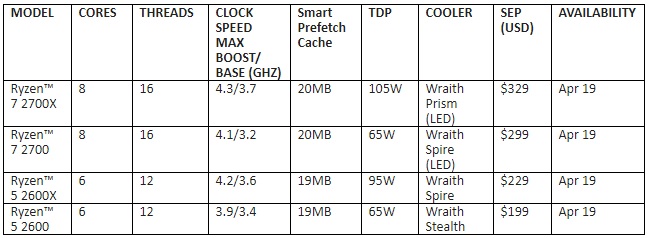
We’ll return to power use shortly, but first, we are going to focus on a few unique aspects of the platform.
StoreMI
One of the features touted in the launch of the 2000-series CPUs was AMD’s StoreMI. It’s a software approach to what Intel offers through Optane hardware, or perhaps even more accurately, what Apple offers with its Fusion drive. In short, it’s a drive “tiering” (don’t call it caching!) solution that AMD is licensing from Enmotus. All owners of X400-series motherboards can download StoreMI for free from AMD. As it turns out, the software package being offered to AMD users is pretty generous, especially given the price, but it’s not the full Enmotus suite, and has some fairly significant limitations that ultimately stopped us from performing any benchmarking tests on it, as we’ll explain in a moment.
Here’s what StoreMI can in theory do: it allows you to combine two drives in a tiered structure such that the software monitors your activity and physically moves often-used data to the faster of the two drives in the tier. So, for example, if you combine a hard drive with a PCIe-based SSD, over time StoreMI will move your operating system and executables to the SSD, and perhaps some of the less-used data to the hard drive.
But here’s the catch: the free version of the Enmotus software being offered as AMD’s StoreMI is very limited. First, it can only tier two drives, so dreams of combining a hard drive with a moderate-sized SATA SSD and a small PCIe SSD just won’t come true. Additionally, it requires a 400-series AMD chipset (likely only for licensing reasons, not for any physical capability on the chipset itself). That’s reasonable enough – AMD wants the consumer to make the investment (i.e., spend some money) to justify providing free software. The biggest problem is that StoreMI just isn’t a complete enough implementation of the Enmotus software suite. You can only use up to 256GB of SSD space (additional space will simply appear as a separate drive partition), and even worse, if you already have your OS on a drive that’s larger than 256GB, it cannot be used at all. So, for example, if you build a PC with a 500GB solid-state drive and then want to add a 4TB hard drive into a tiered system, you can’t unless you move the OS to the hard drive and then tier the drives, which is simply ridiculous. In other words, you’ll need to license the more complete software package from Enmotus.
Because TBG’s suite of SSDs consists entirely of 500GB-class and larger SSDs, we simply couldn’t test StoreMI for you. Our impression is that it’s going to be most useful to shoppers who buy a PC off the shelf with a Ryzen 2000-series processor (and 400-series chipset), and come to realize that the hard drive that HP, Acer, Dell, etc. has loaded the OS on is complete garbage. At that point, rather than suffering from an acute case of buyer’s remorse, these users can go out and buy a 250GB solid-state drive, load up StoreMI for free, and take full advantage of drive tiering with very little effort (read: no OS cloning or re-installation). In fact, AMD takes pains to mention that if you follow this approach, StoreMI will migrate the bulk of the user’s OS installation to the SSD, without any intervention from the user at all, other than installing StoreMI and “flipping on” the switch (yet, it is that simple). While you could clone an OS installation on an OEM machine, it’s not a fool-proof option, and typical OEM buyers just don’t have the ability or patience to deal with it. That’s who we think StoreMI is for, and we commend AMD for offering this free alternative to Intel’s added-cost Optane solution. We believe, however, that most TBG readers won’t find it all that compelling.
Memory Compatibility
In our initial review, we confirmed that AMD was able to vastly improve Ryzen’s compatibility with ultra-high-speed memory sticks, particularly those that used single-ranked designs. We successfully ran our systems using a 2x8GB DDR4-3400 kit from G.Skill that utilized a single-rank design. We only had two of those sticks on hand, however, and we really wanted to know whether Ryzen could properly support a 32GB setup. Unfortunately, we found that Ryzen’s compatibility with dual-ranked RAM modules hadn’t improved at all when running with four sticks, meaning our Corsair 4x8GB Vengeance RGB DDR4-3000 kit simply wouldn’t run at anything over 2133MHz. These dual-ranked sticks, which worked perfectly when run as a complete 4-stick kit in every Intel system we tested, and even worked throughout our AMD Ryzen 2000 series testing when just two sticks were used, were therefore not a viable solution as a four-stick set on Ryzen.
We had a hunch that there was more to the story, given how well the single-ranked modules worked. So we did a bit more digging through out parts box to find another couple of modules that we could run with our G.Skill DDR4-3400 RAM just to see if we could get four sticks to boot at over 2133MHz. Lo and behold, we had one other single-ranked kit, which was a Geil 2x8GB DDR4-3000 kit. While we knew that running this kit at 3400MHz wasn’t going to work, that wasn’t a major concern. We just wanted to run four sticks of RAM on our Ryzen 7 2700 at over 2133MHz! And sure enough, when we inserted our two Geil 3000MHz sticks alongside our two G.Skill DDR4-3400 sticks, the system booted right up, displayed the Geil’s XMP DDR4-3000 profile (which translates to 2933MHz on Ryzen), and allowed us to select it for all four sticks without issue. We successfully ran our full suite of benchmarks with four modules running at 2933MHz, so we feel comfortable stating that yes, indeed, Ryzen 2000-series processors and the X470 chipset actually allow you to use all four slots on your motherboard with high-speed RAM! Just make sure you get single-ranked modules. The best way to dig up this specification is by looking at your motherboard’s memory support list, which will always specify whether the RAM is single- or dual-ranked. As an example, here’s the memory support list for our MSI X470 M7 AC.
Overclocking
The highest stable overclock we could achieve was 4.05GHz at 1.35V, compared to the 4.2GHz we hit on our Ryzen 7 2700X at the same voltage. Whether this is binning in effect or just the silicon lottery is impossible for us to say, but we wouldn’t be surprised if the 2700X can hit slightly higher overclocks on average. That being said, enthusiasts who like to see big OC gains will want to go with the 2700, not the 2700X, as our 2700 was 17.5% faster in multi-threaded operations once overclocked (it ran at 3.45GHz on all eight cores at stock, and 4.05GHz is, you guessed it, 17.5% higher!). That’s compared to the anemic 3.5% boost our 2700X gained, since it’s already so close to its maximum. But take note: because of Ryzen’s sophisticated SenseMI boost algorithm, manual overclocking can sometimes hurt performance. Our Ryzen 7 2700 boosted up to 4.1GHz in some single-core benchmarks (thanks in part to the liquid cooler we used), so our manual overclocking to 4.05GHz was actually an underclock in these situations. The situation was even worse with our 2700X, as it boosts to 4.3GHz on a single core, but our manual OC limited it to 4.2GHz.
Throughout our testing on the following pages, we’ll provide benchmarks for both the stock Ryzen 7 2700 and the overclocked Ryzen 7 2700, as well as the stock Ryzen 7 2700X.
Windows 10 Power Profiles
Something we picked up on in our initial Ryzen 2000-series review was that the AMD Ryzen Balanced power profile in Windows 10, originally developed to improve performance of the Ryzen 1000-series, might not work properly with the new processors. And that’s a problem, because it comes up as the default power profile for Ryzen 2000-series CPUs. We therefore ran our entire suite of tests with both profiles, and while the results were identical for nearly all of our tests, a handful stood out as demonstrating that the Ryzen Balanced profile isn’t ideal for the new Ryzen processors, as shown below:
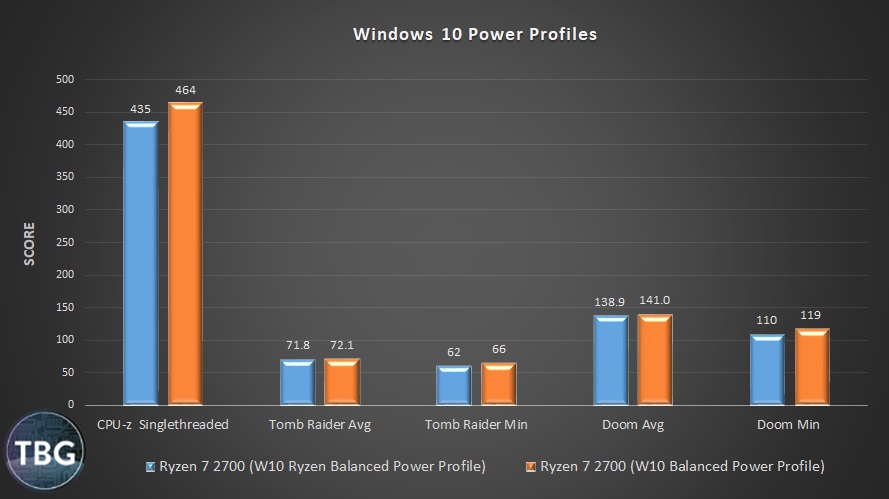
Based on these findings, in the benchmarks that follow we used the standard Balanced profile, not the Ryzen Balanced profile, in order to ensure maximum performance!
Synthetic Benchmarking
CPU-Z Built-in Benchmark
We like to run CPU-z because it’s a free, easy, and safe benchmark to use to get some baseline data.
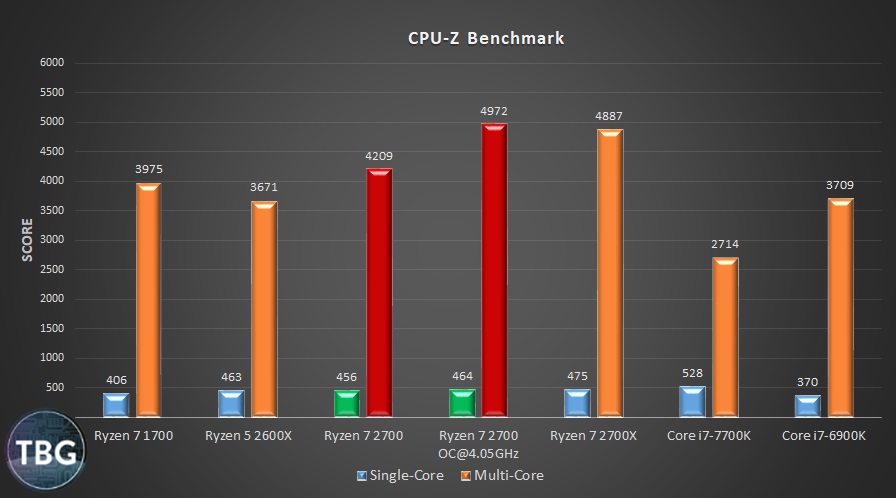
Thanks to a 3% increase in instructions per clock cycle (IPC), plus a slightly higher standard boost clock, the Ryzen 7 2700 easily beats its predecessor the Ryzen 7 1700, notching a 12% win in the CPU-z single-core test, and 6% in the multi-core test. It’s also way out in front of the Intel Core i7-6900K eight-core CPU, launched at $1,100 in May 2016. Oh, how the mighty have fallen! AMD’s Ryzen series has definitely made it much harder for Intel to market its high-end desktop CPUs at high-end prices; the current-gen Core i7-7820X eight-core, which sells for around $500, is actually slower than the Core i7-6900K in many tests!
Once overclocked, the 2700 gets a big boost, at least with regards to the multi-core test. In the single-core test, the 4.05GHz overclock we were able to achieve barely exceeded the boost level that the 2700 hits out of the box, which was around 4GHz in this test. Because the 2700X has such a high boost level when operating on a single core (4.3Ghz in our tests), there’s no way a 2700 is going to match it without some fine tuning of per-core overclocking ratios. And while not shown here, the 2700X was a capable overclocker as well.
Cinebench R15
Cinebench has quickly become one of the most widely-cited benchmarks, probably because like CPU-z, it’s free and easy to use, and it has the added benefit of actually loading up the CPU with a useful task: rendering an image!
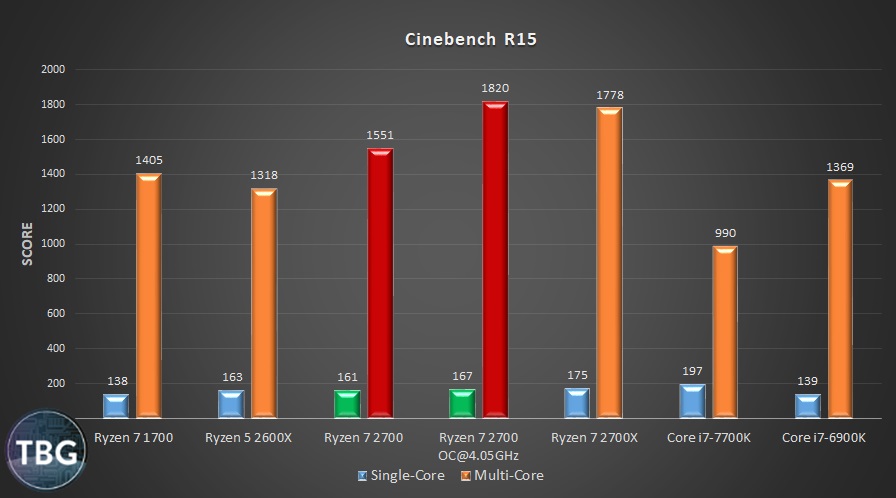
The Ryzen 7 2700 again puts up some very good results, offering performance 10-15% ahead of its predecessor. But while its overclocked numbers are very impressive, note how they compare to the stock 2700X – a small win in multi-core, but a bigger loss percentage-wise in single-core.
3DMark Time Spy
To give us another baseline, we’re going to give you the numbers generated by 3DMark Time Spy, the newest in a long line of easily-comparable benchmarks from FutureMark. It’s now owned by UL, the respected testing company previously known as Underwriters Laboratories. While it’s marketed as a gaming benchmark, it actually has a very good CPU-specific test that provides a separate score from the graphics card tests, and it’s the one we provide detailed data for in the graph below.
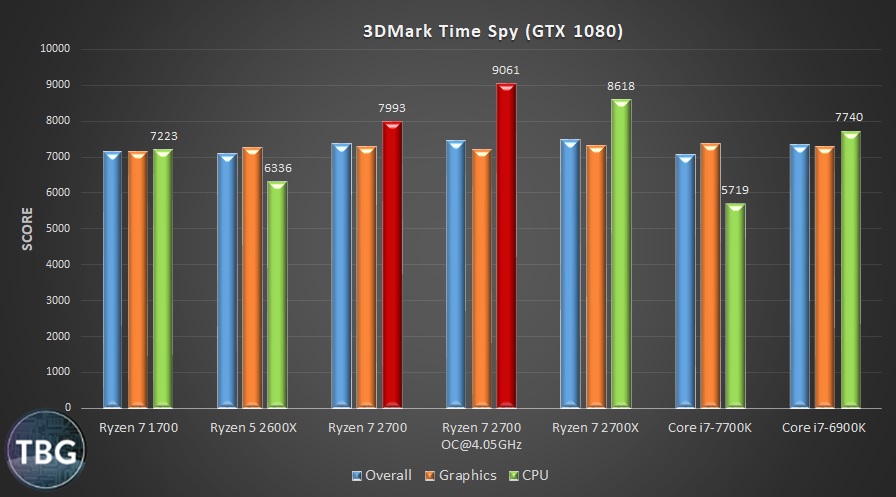
Time Spy harnesses Microsoft’s DirectX 12, a lower-level graphics API than its predecessor DX11. It’s harder to code for, but also allows developers to get “closer to the metal”, i.e., the CPU. It should in theory take better advantage of all of a CPU’s cores, as well as Hyperthreading (or Simultaneous Multithreading, in AMD-speak).
To interpret the results, we suggest you focus on the red bars (the Ryzen 7 2700’s CPU Score). AMD has a solid lead here over Intel, and even if we’d had Intel’s newest chips in this test, AMD still wins in terms of performance per dollar. But take note: a win in 3DMark’s CPU test, which propels AMD to small wins in the overall score as well, doesn’t necessarily translate to better gaming performance.
Game Benchmarking
We ran real in-game benchmarks on three popular titles: Rise of the Tomb Raider (3rd-person adventure), DOOM (first-person shooter), and Rocket League (an e-sports title). We think they provide a pretty representative look at gaming today.
Rise of the Tomb Raider
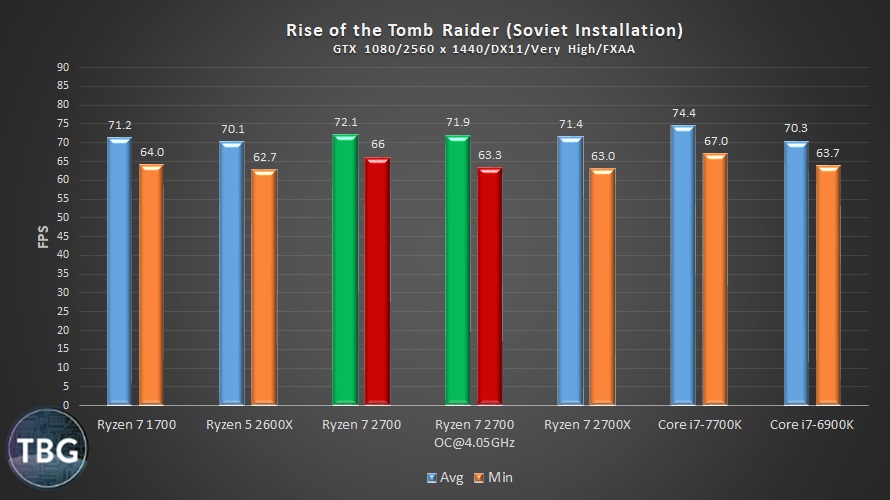
The Ryzen 7 2700 looks good here, but note that the lead it has on the other Ryzens is due to the Windows power profile we used – Balanced rather than the Ryzen Balanced used for the 2600X and 2700X. Note also that our overclock doesn’t help performance – we think this is in part because it doesn’t boost single-core speed significantly.
DOOM
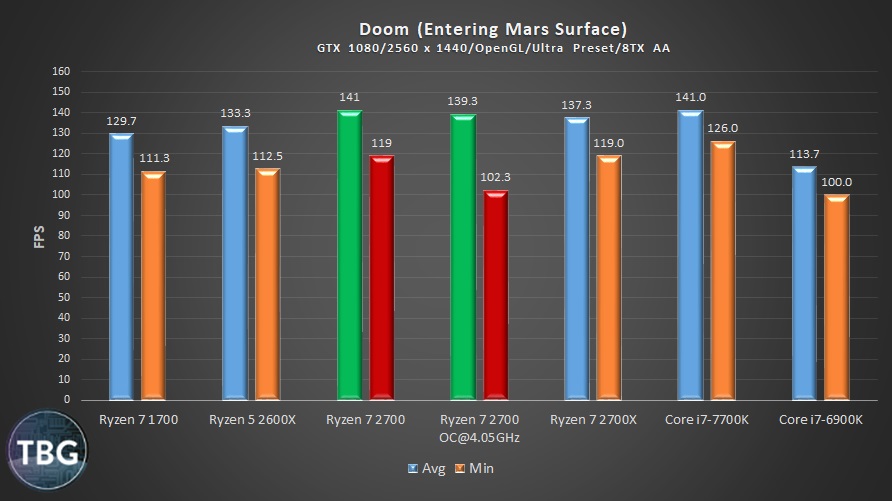
Performance of the stock Ryzen 7 2700 was exceptional here, even besting the Ryzen 7 2700X, and nearly equaling the Intel Core i7-7700K. Again, overclocking didn’t help here. The performance was also very erratic from run to run (we did three runs), unlike the consistent performance of the stock 2700. It’s possible that the OC isn’t holding the same speed for all cores, even though we set them all at 4.05GHz.
Rocket League
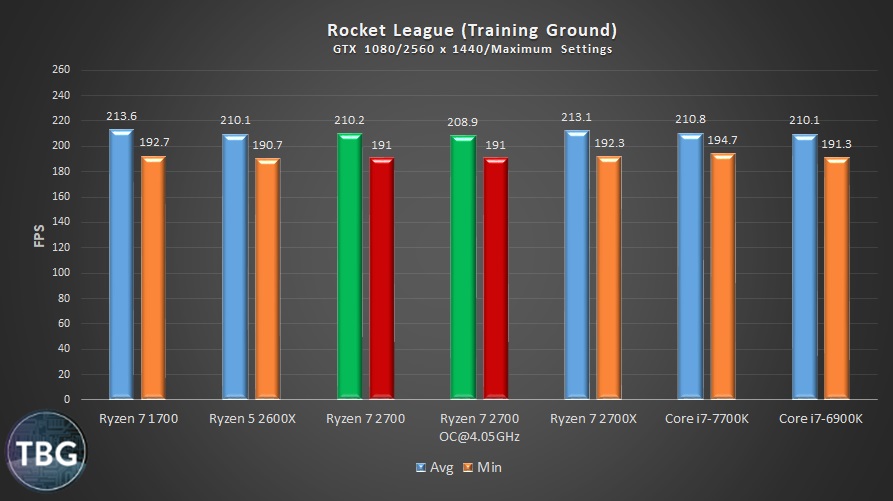
As it turns out, all of our test platforms allowed the GTX 1080 video card we used to run at its maximum potential, achieving just over 210 frames per second on average. That’s really, really fast, and it’s the kind of number competitive e-Sports gamers probably like to see. The Ryzen 7 2700 in both stock and overclocked forms more or less matched the other processors.
Power Use
AMD has touted the efficiency of its new 12nm Pinnacle Ridge architecture as one of its best features, but in our testing, we found that our X-series 2nd-gen Ryzen chips didn’t exhibit particularly efficient behavior. Based on testing two motherboards, we know that part of this does come down to decisions made by motherboard manufacturers (for example, our Asus X470 CrossHair VII Hero used less power than our MSI X470 M7 AC). Clearly, however, AMD was pushing its chips pretty hard to come up with boost levels over 4GHz.
We were therefore very curious to see if a non-X processor could legitimately be called efficient. The TDP of the Ryzen 7 2700 is just 65W, a full 40W lower than the Ryzen 7 2700X that we previously tested. How does that translate to reality? See for yourself below!

Yes, indeed, the Ryzen 7 2700 uses a whole lot less power than the 2700X (on the same motherboard, mind you). This is a true win for AMD. In fact, in all of our previous benchmarks, you saw the Ryzen 7 2700 beating the Core i7-6900K, which is Intel’s previous-gen eight-core processor, which happens to use a bit more power. In terms of productivity use, the Ryzen 7 2700 soundly beats its stablemate the Ryzen 5 2600X, a six-core processor that runs at higher clocks, but has far less multi-tasking capability.
With that said, once we overclocked the Ryzen 7 2700 to run faster than our Ryzen 7 2700X, it operates a whole lot like a Ryzen 7 2700X, in fact drawing a bit more power.
The Cooler/Pricing Situation
We tested our Ryzen 7 2700 with a third-party liquid cooler in order to achieve the best overclocks, but we wanted to say a few words about the coolers AMD is shipping with its processors. First, we want to commend AMD for choosing to include coolers with all its CPUs this time around, as its decision to ship all of its 1000-series X-series chips without coolers when Ryzen first hit the market was a big mistake. Sure, Intel had already gone down that path with its “K-series” overclockable processors, but there was a huge installed base of Intel-compatible coolers. Out of the gate, you couldn’t buy any coolers for the 1700X and 1800X last year, which was a disaster.
AMD clearly learned from its mistakes, as all Ryzen CPUs now come with coolers. But this leads to a marketing problem for AMD: the 2700X is now a much better value than the 2700. Last year, the Ryzen 7 1700 arrived at $330 with a cooler, and the Ryzen 7 1700X arrived at $400 without a cooler. Because both could reach similar overclocks, the 1700 was a great value proposition, which in turn hurt 1700X sales (not to mention sales of the overpriced $500 Ryzen 7 1800X). Below you can see the three cooler styles AMD is offering up this time around, along with heights and weights that we measured ourselves.

So, to recap, the Ryzen 7 2700 launched at $300 with the Wraith Spire RGB Cooler, and the Ryzen 7 2700X launched at $330 with the superior Wraith Prism RGB Cooler. In fact, in what we’d consider market segmentation run amok, each of the Ryzen 2000-series processors comes with a different cooler: the Ryzen 5 2600 arrives with the Wraith Stealth, the Ryzen 5 2600X gets the Wraith Spire, the Ryzen 7 2700 gets the Wraith Spire with RGB, and the 2700X gets the Wraith Prism RGB. This can’t be cost-effective for AMD’s production lines (or for bulk pricing from wherever it sources these coolers). We understand that AMD probably didn’t want to tarnish the image of its high-end offering as it did with the previous generation, but with just $30 separating the 2700 and 2700X, and given that the 2700X is far faster and includes a better cooler, the 2700 is a very hard sell. And even if you’re building a small form factor PC, the Ryzen 7 2700 offers little benefit, as its cooler still sits at 72mm tall according to our measurements, which puts it over the limit for most slimline cases.
With that being said, the Wraith Prism included with the 2700X is by far the most impressive box cooler we’ve ever seen. Too bad it’s not included with the 2700, whose users would be more likely to actually install it. With a big copper baseplate, four copper heatpipes, and a big fin array, it’s immensely capable, and its lighting effects are very cool. It offers both an addressable ring and a user-selectable fan light, as shown below, versus the somewhat boring Spire RGB:
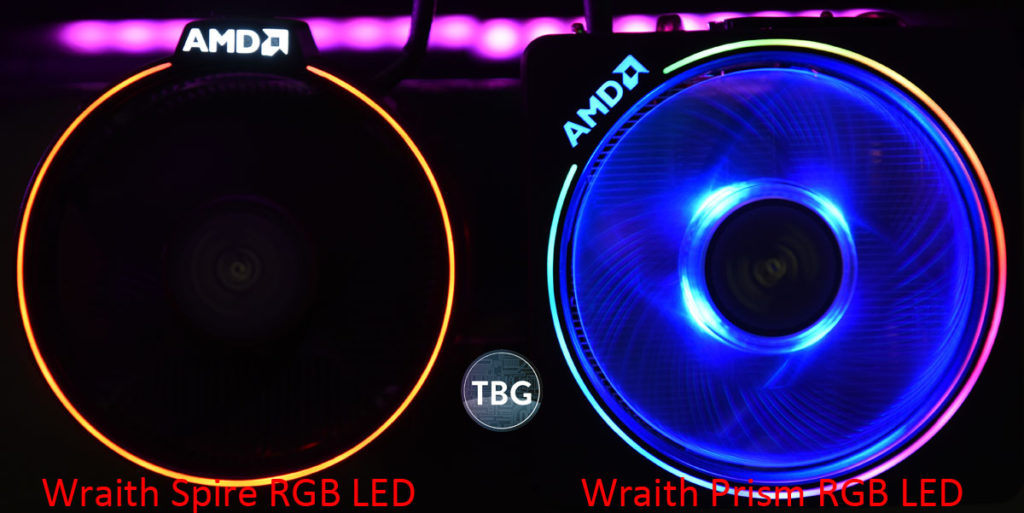
It’s a shame, then, than the 2700X really is too much CPU for a downdraft cooler like the Prism, which ran a little loud in our previous testing of the 2700X (and limited boost somewhat), making a custom cooler the best approach for the 2700X, and one we suspect most enthusiasts would use. But that brings us to another reason we think most users should go with the 2700X: out of the box, it operates at very close to its maximum overclock. That’s actually a good thing in the sense that it limits the amount of tinkering you have to do to get the most out of it. Yes, you can overclock the 2700, but not beyond what the 2700X can do (our sample barely matched a stock 2700X in fact). The thrill of overclocking loses some of its shine when you’re paying nearly as much to achieve the same performance. Honestly, if it had been up to us, we would have marketed the 2700 with the Prism cooler at $330, and the 2700X without a cooler at the identical price. That would have given users the option of an attractive out-of-the-box solution in the 2700, or a solution intended for maximum-performance in custom builds with the 2700X.
Conclusion
We like what AMD has done with the Ryzen 7 2700, and think it’s a great pick for a certain usage scenario. At stock settings, it’s massively-efficient, besting even Intel’s latest in terms of performance per Watt in heavily-threaded operations. That also makes it a great pick for compact systems, which we can’t say for the 2700X, as it draws a bit too much power to use a small cooler. The 2700 also offers users the flexibility of stepping up to 2700X-class performance by overclocking, as long as they equip it with sufficient cooling.
The AMD Ryzen 7 2700 retails for $299.99, and is discounted to $289.99 shipped free from Amazon as of our publication date, offering a nice upgrade from the previous-gen Ryzen 7 1700 for around the same price. With that said, we think most enthusiasts are better served by the Ryzen 7 2700X. It hits much higher clocks out of the box, potentially overclocks even higher, and comes with a better cooler.
If you’re ready to put together a Ryzen-based system of your own, check out our monthly PC Buyer’s Guides, which have already been updated with a number of systems featuring AMD’s new Pinnacle Ridge platform!

